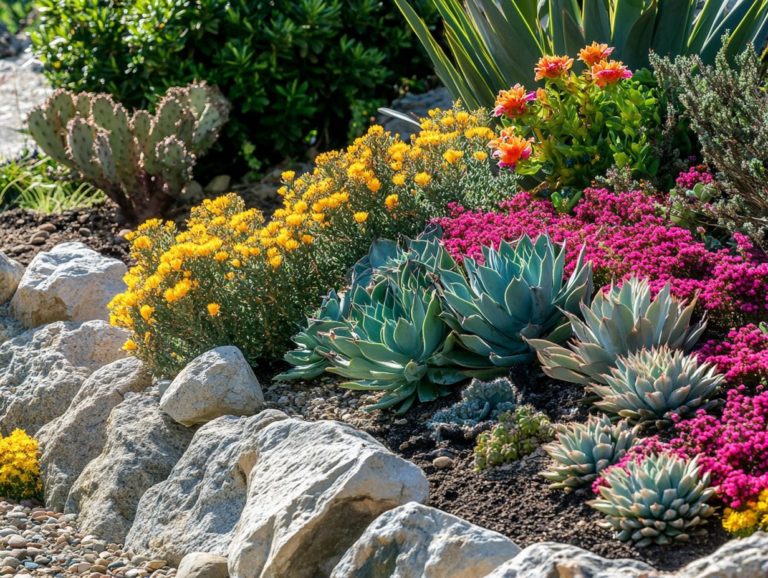Seasonal Care for Drought-Tolerant Species
Drought-tolerant species are becoming increasingly essential for sustainable gardening and landscaping, particularly in regions where water scarcity is a concern.
This article delves into the numerous benefits these resilient plants offer, from their positive environmental impact to their remarkable ability to conserve water.
You will also learn how to select the right species tailored to your specific environment. Dive in to discover how to make a lasting, eco-friendly choice for your garden!
Contents
- Key Takeaways:
- Understanding Drought-Tolerant Species
- Benefits of Choosing Drought-Tolerant Species
- Seasonal Care for Drought-Tolerant Species
- Common Mistakes to Avoid
- Choosing the Right Drought-Tolerant Species for Your Area
- Frequently Asked Questions
- What is considered a drought-tolerant species?
- What are some examples of drought-tolerant species?
- Do drought-tolerant species still need water?
- How often should I water my drought-tolerant plants?
- Can I fertilize my drought-tolerant plants?
- How should I care for my drought-tolerant plants during different seasons?
Key Takeaways:

- Choose drought-tolerant species to conserve water and reduce environmental impact.
- Proper seasonal care is crucial for the survival and health of drought-tolerant species.
- Avoid common mistakes, such as overwatering, when caring for drought-tolerant species.
Understanding Drought-Tolerant Species
Understanding drought-tolerant species is essential in today s climate, where water scarcity is a pressing concern. These plants are well-suited to thrive in arid conditions while demanding minimal water.
In regions like California, Arizona, and Mexico, choosing the right flora can elevate your landscape design. This choice champions water conservation and enhances soil health.
By integrating drought-tolerant plants such as Yucca, Manzanita, and Phormium into your garden, you can cultivate a vibrant landscape that not only attracts beneficial insects but also alleviates problems like root rot and heat stress.
What are Drought-Tolerant Species?
Drought-tolerant species are the plants that have mastered the art of surviving in low-water environments, making them the perfect choice for your sustainable landscaping and water-wise endeavors.
These remarkable plants come equipped with unique special features, like reduced leaf surface area, fleshy stems, and deep root systems, all designed to minimize moisture loss and optimize water uptake.
In various USDA zones, the benefits of these plants are clear as they consistently outperform traditional plants in arid conditions. Unlike their thirsty counterparts, which demand regular irrigation and constant care, drought-tolerant varieties embody resilience and low maintenance.
Consider succulents, with their plump leaves perfectly engineered for water storage, or cacti, celebrated for their ability to flourish in extreme heat. They offer aesthetic appeal without sacrificing environmental sustainability, making them a smart addition to any landscape.
Benefits of Choosing Drought-Tolerant Species
Opting for drought-tolerant species presents a multitude of advantages that go well beyond visual appeal. These plants play a crucial role in water conservation, minimize the demands of landscape maintenance, and foster local ecosystems by offering habitats for beneficial insects.
Water Conservation and Environmental Impact
Water conservation emerges as a pivotal advantage when you embrace drought-tolerant species in your landscape design, particularly in regions susceptible to drought conditions.
These remarkable plants, expertly adapted to flourish with minimal water, significantly reduce the overall demand for irrigation. By integrating drought-tolerant varieties into your urban gardens and public parks, you can dramatically decrease water usage a necessity in an era where climate change brings increasingly erratic weather patterns.
These resilient plants also play a crucial role in mitigating soil erosion and enhancing biodiversity, making them essential allies in your sustainable landscaping efforts. Their knack for thriving on scant rainfall not only conserves this precious resource but elevates the aesthetics of urban environments. This fosters healthier ecosystems that can thrive amidst the challenges of urbanization.
Seasonal Care for Drought-Tolerant Species

Seasonal care for drought-tolerant species is vital for preserving their health and resilience year-round. To learn more about the specific practices needed for different seasons, including protective measures during winter and strategic pruning in the summer, check out what is the best seasonal care for drought plants.
Embracing these tailored approaches ensures your plants thrive through every shift in climate.
Spring Care
Spring care for drought-tolerant species is key to helping your plants thrive. Focus on improving soil quality and applying mulch to shield plant crowns from heat stress.
Prepare your soil well to boost drainage and nutrients, helping roots establish effectively. Testing the soil acidity level and enriching it with organic matter, like compost, can significantly enhance its structure.
When you apply a layer of mulch whether it’s organic, like wood chips, or inorganic, like gravel you re not just retaining moisture; you re also regulating soil temperature. These thoughtful practices create a healthier environment for your plants, reducing their risk of drought stress during the hotter months.
Summer Care
Summer care for drought-tolerant species revolves around managing heat stress and knowing when to water drought-resistant plants while implementing effective water conservation strategies to keep your plants thriving.
To achieve this, establish a structured watering schedule that prioritizes deep irrigation. This allows roots to access moisture reserves while preventing surface runoff. Water either early in the morning or late in the evening to minimize evaporation, ensuring every precious drop counts.
Be vigilant against common pests this season, as the heat can encourage their proliferation. Employ shading techniques, such as using cloth or strategically placing taller plants for cover, to reduce direct sunlight exposure. By utilizing organic and preventive pest management strategies, you protect the foliage and maintain a healthy, vibrant landscape throughout the summer.
Fall Care
Fall care for drought-tolerant species requires thoughtful preparations for dormancy, including pruning shrubs and winter care for drought-resistant plants to create environments that nurture beneficial insects during the cooler months.
This seasonal strategy not only bolsters the health of your plants but also enriches the local ecosystem. By carefully pruning your shrubs, you encourage new growth while eliminating any dead or diseased branches that attract pests. This enhances the visual appeal of your landscape and provides vital habitats for birds and beneficial insects.
Keep your garden vibrant before winter arrives to support both plants and the wildlife that depend on them.
Winter Care
Winter care for drought-tolerant species is crucial to shield dormant plants from harsh conditions. Implementing seasonal plant care techniques can help prevent root rot and secure their survival until spring arrives.
As the cold season sets in, adopt careful watering techniques, such as light irrigation during dry spells, to maintain moisture levels without drowning the roots something that often invites rot.
Covering the crowns of your plants with mulch or burlap acts as insulation against extreme temperature fluctuations, significantly reducing the risk of freeze damage. Act now to protect those vulnerable roots and ensure your plants thrive through winter!
Common Mistakes to Avoid

Caring for drought-tolerant plants can be a rewarding adventure. By avoiding common mistakes, you can ensure your plants thrive!
Avoiding common mistakes in caring for drought-tolerant plants is essential for ensuring their health and resilience. Pay close attention to issues like overwatering, which can result in detrimental effects such as root rot.
By being mindful of these factors, you can cultivate a thriving environment for these resilient plants.
Overwatering and Other Pitfalls
Overwatering is a frequent misstep in caring for drought-tolerant plants, and it can lead to significant problems like root rot.
This often happens when you, eager to nurture your greenery, misjudge their moisture needs and end up giving them too much water. Factors contributing to this mistake include inconsistent watering schedules, poorly draining soil, and inadequate pot drainage.
The consequences of overwatering can be quite visible yellowing leaves, mold growth, and, in the worst cases, plant death. Act quickly to adjust your watering habits to save your plants!
To prevent these pitfalls, it’s essential to understand how much water these plants need. Strategies such as checking soil moisture levels, selecting pots with drainage holes, and adjusting your watering frequency according to the season can significantly enhance plant health.
It’s also important to avoid common care errors, like neglecting light requirements or forgetting to repot when necessary, for maintaining a flourishing garden.
Choosing the Right Drought-Tolerant Species for Your Area
Selecting the ideal drought-tolerant species for your region demands thoughtful consideration of several factors. You ll want to take into account the local climate, plant hardiness zones defined by the USDA, and your specific landscape design aspirations. For instance, species like Daphne and Japanese Maple may be suitable for certain climates.
Factors to Consider
When selecting drought-tolerant species, you must consider several factors, including soil conditions, local climate, and water availability. The overall aesthetic goals of your landscape design play a crucial role in this decision-making process.
For instance, your choice of plants may vary dramatically if you re aiming for a lush garden aesthetic versus a more minimalist, arid landscape.
Soil type whether sandy, clay, or loamy directly impacts water retention capabilities and nutrient availability, making it essential to align your plant selections accordingly.
Additionally, regional climatic conditions, such as temperature fluctuations and rainfall patterns, can significantly influence which drought-tolerant species will thrive in your specific area.
Ultimately, understanding these elements will lead you to a more successful and sustainable landscape.
Frequently Asked Questions
What is considered a drought-tolerant species?

A drought-tolerant species can survive long periods without much water.
What are some examples of drought-tolerant species?
Some examples of drought-tolerant species include cacti, succulents, lavender, and rosemary. These plants have adapted to survive in arid climates with little water.
Do drought-tolerant species still need water?
Yes, even drought-tolerant species still need water to survive. However, they are able to tolerate and thrive in drier conditions compared to other plants.
How often should I water my drought-tolerant plants?
Drought-tolerant plants should be watered deeply and infrequently. This means watering them once a week or every 10 days, providing a good soaking to encourage deep root growth.
Can I fertilize my drought-tolerant plants?
You can fertilize your drought-tolerant plants, but it’s not necessary. These plants thrive in soils that lack nutrients and need less fertilization than other plants.
If you choose to fertilize, use a type that provides nutrients gradually, once or twice a year.
How should I care for my drought-tolerant plants during different seasons?
In spring, treat your plants to a refreshing drink after the winter months. In summer, provide some shade during the hottest part of the day.
As temperatures cool in fall, reduce watering. In winter, don t wait too long to water; your plants need it when the soil is completely dry.






